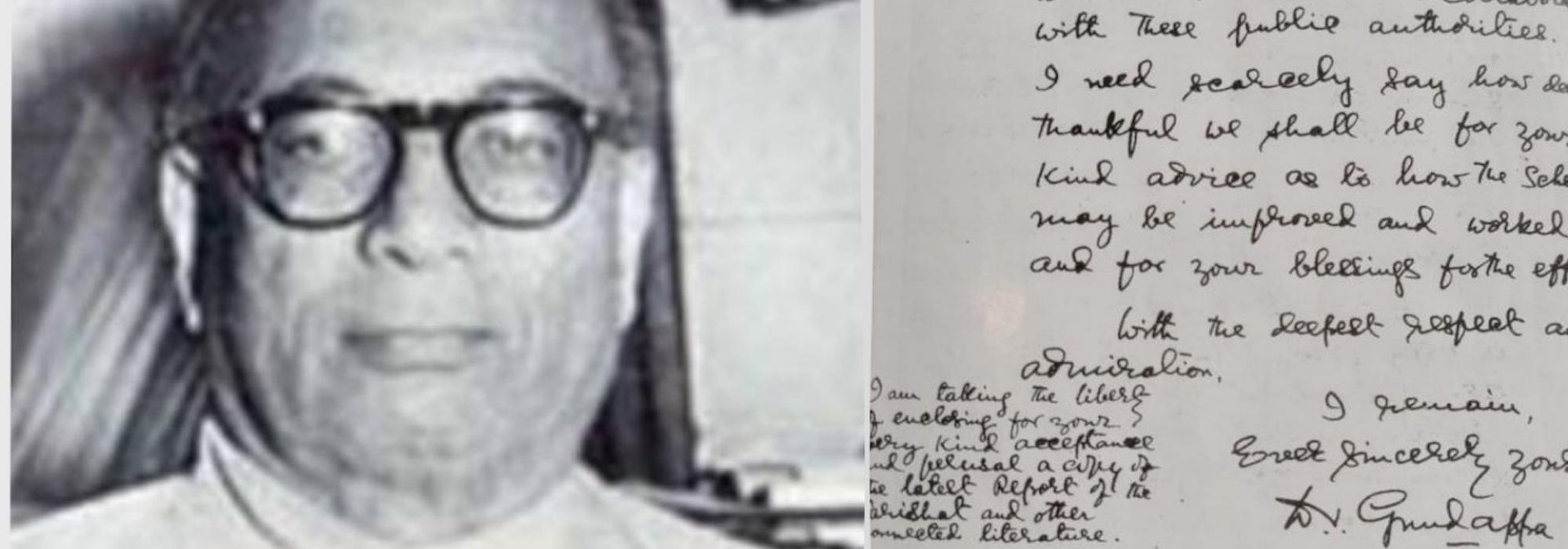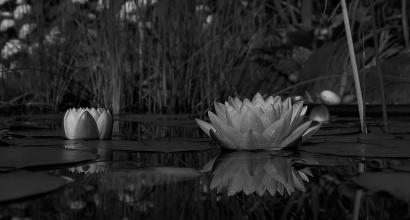DVG has analyzed the major characters of the Mahābhārata in a long essay. His sublime analysis includes discussions on kāla, ṛta and conflicts that arise in the transition from one age to another. This is an exposition that befits the epic dimension of the Mahābhārata.
Gītaśākuntala is a unique work that presents several poignant episodes of Kālidāsa’s Abhijñānaśākuntala in the form of songs. In the introductory section of this work, DVG analyzes the characters of Duṣyanta, Śakuntalā and Kaṇvarṣi with remarkable insight. He looks upon sage Kaṇva as an embodiment of niṣkāma-karma as enunciated by the Bhagavadgītā and as exemplified by Bharata in the Rāmāyaṇa. He observes that the play comes a full circle between the opening and closing verses – from yā sṛṣṭiḥ to punarbhavaṃ kṣapayatu nīlalohitaḥ.
Śrīrāmaparīkṣaṇam and Śrīkṛṣṇaparīkṣaṇam are unique works in which DVG has analyzed Rāma and Kṛṣṇa, two shining ideals of life. One verse here captures all the facets of Kṛṣṇa’s magnificent personality. It is so profound that any list of the best verses on Kṛṣṇa that is worth its salt ought to include it:
veṇusvānamo pāṃcajanyaravamo gītoktagāṃbhīryamo
maunisnehamo gopikāpraṇayamo kauṃteyavātsalyamo /
senānitvamo rājyataṃtranayamo cakrāstrasaṃdhānamo
nānājīvanadharmaraṃgagaḻoḻādarśaṃ yaśodāsutaṃ // (Śrīkṛṣṇaparīkṣaṇam)
Be it in the delicate melodies of the flute, the thunderous roar of the Pāñcajanya, the majesty of the Gītā counsel, friendship with sages, love for gopikās, affection for the pāṇḍavas (particularly Arjuna); be it as a warrior, political strategist or the wielder of the sudarśana-cakra, Kṛṣṇa, Yaśoda’s loving son, is the ideal in the myriad stages of life pertaining to dharma. (Translation by Hari Ravikumar; reordering mine)
DVG’s translations of Omar Khayyam’s Rubaiyats and Shakespeare’s Macbeth are landmarks in Kannada literature. While the translations are themselves splendid, the introductions that DVG wrote to these works are worth their weight in gold. His analysis of the relative merits of Lucretius, Robert Browning and Omar Khayyam from the perspective of Vedānta is remarkable. The perspective he brings to bear on the analysis of tragedy is unique and profound.
Śrīvidyāraṇyaru mattu avara Kāla and Vidyāraṇyara Samakālīnaru are works that bear testimony to DVG’s attainments as a first-rate researcher. Sāyaṇa and Mādhava are two of the most illustrious sons of Karnataka. DVG spared no pains in going through a vast body of literature—both printed books and manuscripts—to bring to light invaluable historical facts about them, the milieu of the time in which they lived, and the fraternity of scholars before and after them.
Maṅkutimmana Kagga is a bouquet of verses that captures DVG’s meditations on life. It was addressed to the proverbial common man who forms a major part of the society. It soon won legions of unpretentious worshippers and made DVG a household name in Karnataka. The reasons for its stellar success are many. Being the creation of a man who had drunk deep from the fountain of life, Kagga draws our attention to the profound aspects of everyday life that we are likely to miss, being entangled in the maze of frenzied activity. It talks to us in a tone of gentle persuasion. It performs the role of a companion – a learned, reliable and compassionate friend who holds our hand and walks us through the highways and byways of the sprawling city of life. It is āpta-vākya in the truest sense.
Kagga does not attempt to simplify life or provide readymade solutions to personal problems. It drives out pessimism and pusillanimity and ushers in ardour, refinement and forbearance. It asks us to avoid extremism (ati beḍavèlliyuṃ 724) and live in the present (indigī matavucita 939). Suppose we are morose, it gives us reassurance (èṣṭādaraṣṭè sari 583, pada kusiyè nèlavihudu 600); if we are riding the wave of overconfidence, it brings us back to reality (pèṭṭu tinnuvè jokè 532, spardhiyè trivikramagè 292). It urges us to accept life as it is—comprising both the good and bad—but asks us to fight for the good by invoking images and metaphors etched in our cultural memory (rāmabhaṭanāgu nīṃ 288). It teaches us truths about such fundamental concepts as dharma, anubhava and yoga (śuddhasatyava jīvitapraśnèganvayipa paddhatiyè dharma 545, anubhavavè diṭadaḻatè 393, vyasanamayasaṃsāradali vinodava kāṇba rasikateyè yoga 241) and equips us to live an enjoyable and satisfying life, which others find helpful and meaningful.
Saṃskṛti and Bāḻigondu Nambikè are monographs that are arguably the best examples of self-help books. The first book discusses the concept of culture from multiple viewpoints and presents pragmatic ideas to enhance the quality of personal life. The second book extends their scope by setting the individual against the backdrop of society. DVG listed five essential traits of a cultured person. The world will be a better place if everyone adopts them at least partially:
- Svasthāna-parijñāna – Understanding our place or status.
- Pareṅgita-parigrahaṇa – Understanding others’ intentions.
- Svārtha-niyamana – Regulation of personal desires and self-interest.
- Samanvaya-dṛṣṭi – An attitude to seek harmony and reconciliation.
- Sarasatè – Gentleness, finesse and refinement.
DVG’s thoughts on literature and literary theory are fresh and valuable. He was of the firm opinion that poetry should have a positive bearing on human life. He says:
Good poetry fascinates the ear by the phonic properties of the words it uses and the rhythm of their arrangement. At the same time, the sense of those words raises pictures in our mind, working upon our memory and on the knowledge we already possess of the world and its ways. The sound gives vividness and intensity to the sense; and the sense vitality and value to the sound. In cooperation, the two create in our consciousness a world different from the one we found about ourselves before. That creation, let us note carefully, is really a collaboration between what the poet has put into his words and what we have developed from within ourselves—between his skill in the use of words and our sensibility to their significance—between the deftness of his fingers and the fineness of our clay—between his stimulus and our responsive faculty … The essence of poetry is emotion culminating in reflection. It is pregnant speech issuing in illuminated silence. (Selected Writings of D. V. Gundappa, vol. 5, pp. 294–95, 297)
Going by the etymological meaning of the word sāhitya, he defines literature as the unison of several things: the aspirations of our inner world and the order of the outer world; creative imagination, erudition and practice; expression and experience; instruction and enjoyment, and so on (Kāvyasvārasya, pp. 3–7). He gives us an elevated vision of poetry by describing it in the tone of the Taittirīyopaniṣad:
Athādhikāvyam / kavipratibhā pūrvarūpam / śrotṛhṛdayamuttararūpam /rasānubhūtiḥ sandhiḥ /vākkauśalam sandhānam / ityadhikāvyam // (Kāvyasvārasya, p. 9)
The poet’s creative imagination is the initial object, the listener’s heart is the final object, aesthetic experience is the junction between these two and felicity of expression is the medium that brings about this process.
DVG’s essay titled Kāvyopāsanè in Kannada is an intimate and comprehensive introduction to Indian aesthetics.
Jñāpakacitraśālè is a collection of DVG’s reminiscences spread over eight volumes in nearly 2,500 pages. Nāḍoja S R Ramaswamy has comprehensively described the uniqueness of this series. I can do no better than quote his exact words:
What distinguishes these writings is their special alchemy comprising not merely vibrant personality portraits but also vignettes of family life of bygone days, the social scenario of the period and in some parts the political and administrative configuration in the pre-Independence era. Such is the keenness of observation with which DVG was endowed that much of the documentation in these writings is not to be found anywhere else. What is written is eminently worth writing, and it comes to the reader in a lucid and intimate style, unburdened by pedantry, frequently enlivened by gentle humour. In fact, many read these essays merely for their human interest. Thus the content and the form are both equally endearing. Added to this is the richness of detail which transmutes everyday occurrences into memorable events. It is not surprising that since publication these writings of DVG have come to be regarded as not merely a unique documentation encapsulating the flavour of life of the people three generations ago but also as indispensable source material for reconstructing social history. (Foreword to Art Gallery of Memories, p. 9)
These writings are fine examples of interpretive biography or creative non-fiction, which DVG had made his forte. They sketch the lives of people with anecdotes and not tiresome lists of dates and achievements. DVG tells us the stories of poets and pundits, businessmen and bureaucrats, masons and mendicants, artists and aristocrats. He writes about everyone with great empathy, amazing the readers with his prodigious memory. As Śatāvadhānī R Ganesh puts it, Jñāpakacitraśālè is DVG’s gadya-mahākāvya (prose epic).










































